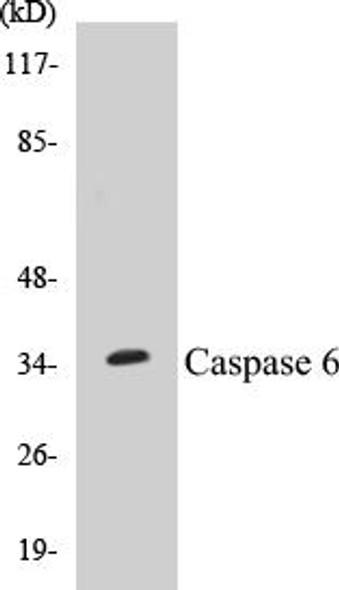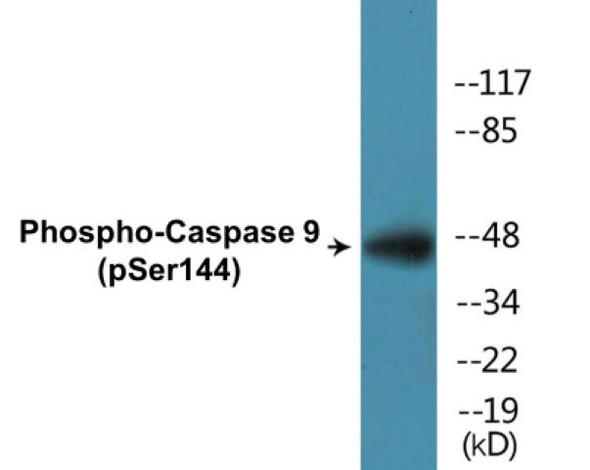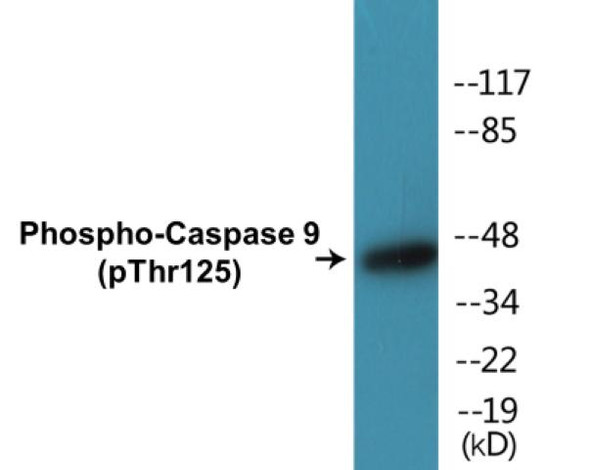Description
Caspase 6 (Phospho-Ser257)Colorimetric Cell-Based ELISA Kit
The Caspase-6 Phospho-Ser257 Colorimetric Cell-Based ELISA Kit from Assay Genie is a powerful tool for accurately measuring levels of phosphorylated Caspase-6 at Ser257 in cell lysates. This kit offers high sensitivity and specificity, ensuring precise and reliable results for your research needs.Caspase-6 is a key enzyme involved in apoptosis, the process of programmed cell death. Phosphorylation at Ser257 plays a crucial role in regulating Caspase-6 activity, making it a valuable marker for studying cell death pathways and developing targeted therapeutics.
With easy-to-follow protocols and a streamlined workflow, the Caspase-6 Phospho-Ser257 Colorimetric Cell-Based ELISA Kit is suitable for a variety of experimental settings, including drug discovery, cancer research, and cell biology studies. Trust Assay Genie for top-quality ELISA kits to advance your research goals.
| Product Name: | Caspase 6 (Phospho-Ser257)Colorimetric Cell-Based ELISA Kit |
| Product Code: | CBCAB01233 |
| ELISA Type: | Cell-Based |
| Target: | Caspase 6 (Phospho-Ser257) |
| Reactivity: | Human, Mouse, Rat |
| Dynamic Range: | > 5000 Cells |
| Detection Method: | Colorimetric 450 nm |
| Format: | 2 x 96-Well Microplates |
The Caspase 6 (Phospho-Ser257) Colorimetric Cell-Based ELISA Kit is a convenient, lysate-free, high throughput and sensitive assay kit that can detect Caspase 6 protein phosphorylation and expression profile in cells. The kit can be used for measuring the relative amounts of phosphorylated Caspase 6 in cultured cells as well as screening for the effects that various treatments, inhibitors (ie. siRNA or chemicals), or activators have on Caspase 6 phosphorylation.
Qualitative determination of Caspase 6 (Phospho-Ser257) concentration is achieved by an indirect ELISA format. In essence, Caspase 6 (Phospho-Ser257) is captured by Caspase 6 (Phospho-Ser257)-specific primary (1ø) antibodies while the HRP-conjugated secondary (2ø) antibodies bind the Fc region of the 1ø antibody. Through this binding, the HRP enzyme conjugated to the 2ø antibody can catalyze a colorimetric reaction upon substrate addition. Due to the qualitative nature of the Cell-Based ELISA, multiple normalization methods are needed:
| 1. | A monoclonal antibody specific for human GAPDH is included to serve as an internal positive control in normalizing the target absorbance values. |
| 2. | Following the colorimetric measurement of HRP activity via substrate addition, the Crystal Violet whole-cell staining method may be used to determine cell density. After staining, the results can be analysed by normalizing the absorbance values to cell amounts, by which the plating difference can be adjusted. |
| Database Information: | Gene ID: 839, UniProt ID: P55212, OMIM: 601532, Unigene: Hs.654616 |
| Gene Symbol: | CASP6 |
| Sub Type: | Phospho |
| UniProt Protein Function: | CASP6: Involved in the activation cascade of caspases responsible for apoptosis execution. Cleaves poly(ADP-ribose) polymerase in vitro, as well as lamins. Overexpression promotes programmed cell death. Heterotetramer that consists of two anti-parallel arranged heterodimers, each one formed by a 18 kDa (p18) and a 11 kDa (p11) subunit. Interacts with BIRC6/bruce. Activation is suppressed by phosphorylation at Ser-257. Belongs to the peptidase C14A family. 2 isoforms of the human protein are produced by alternative splicing. |
| UniProt Protein Details: | Protein type:Protease; Apoptosis; EC 3.4.22.59 Chromosomal Location of Human Ortholog: 4q25 Cellular Component: nucleoplasm; cytoplasm; cytosol Molecular Function:identical protein binding; protein binding; cysteine-type endopeptidase activity; cysteine-type peptidase activity Biological Process: epithelial cell differentiation; apoptosis; proteolysis; cell structure disassembly during apoptosis |
| NCBI Summary: | This gene encodes a protein which is a member of the cysteine-aspartic acid protease (caspase) family. Sequential activation of caspases plays a central role in the execution-phase of cell apoptosis. Caspases exist as inactive proenzymes which undergo proteolytic processing at conserved aspartic residues to produce two subunits, large and small, that dimerize to form the active enzyme. This protein is processed by caspases 7, 8 and 10, and is thought to function as a downstream enzyme in the caspase activation cascade. Alternative splicing of this gene results in two transcript variants that encode different isoforms. [provided by RefSeq, Jul 2008] |
| UniProt Code: | P55212 |
| NCBI GenInfo Identifier: | 26006981 |
| NCBI Gene ID: | 839 |
| NCBI Accession: | P55212.2 |
| UniProt Secondary Accession: | P55212,Q9BQE7, |
| UniProt Related Accession: | P55212 |
| Molecular Weight: | 33,310 Da |
| NCBI Full Name: | Caspase-6 |
| NCBI Synonym Full Names: | caspase 6, apoptosis-related cysteine peptidase |
| NCBI Official Symbol: | CASP6 |
| NCBI Official Synonym Symbols: | MCH2 |
| NCBI Protein Information: | caspase-6; apoptotic protease MCH-2; caspase 6, apoptosis-related cysteine protease |
| UniProt Protein Name: | Caspase-6 |
| UniProt Synonym Protein Names: | Apoptotic protease Mch-2 |
| Protein Family: | Caspase |
| UniProt Gene Name: | CASP6 |
| UniProt Entry Name: | CASP6_HUMAN |
| Component | Quantity |
| 96-Well Cell Culture Clear-Bottom Microplate | 2 plates |
| 10X TBS | 24 mL |
| Quenching Buffer | 24 mL |
| Blocking Buffer | 50 mL |
| 15X Wash Buffer | 50 mL |
| Primary Antibody Diluent | 12 mL |
| 100x Anti-Phospho Target Antibody | 60 µL |
| 100x Anti-Target Antibody | 60 µL |
| Anti-GAPDH Antibody | 60 µL |
| HRP-Conjugated Anti-Rabbit IgG Antibody | 12 mL |
| HRP-Conjugated Anti-Mouse IgG Antibody | 12 mL |
| SDS Solution | 12 mL |
| Stop Solution | 24 mL |
| Ready-to-Use Substrate | 12 mL |
| Crystal Violet Solution | 12 mL |
| Adhesive Plate Seals | 2 seals |
The following materials and/or equipment are NOT provided in this kit but are necessary to successfully conduct the experiment:
- Microplate reader able to measure absorbance at 450 nm and/or 595 nm for Crystal Violet Cell Staining (Optional)
- Micropipettes with capability of measuring volumes ranging from 1 µL to 1 ml
- 37% formaldehyde (Sigma Cat# F-8775) or formaldehyde from other sources
- Squirt bottle, manifold dispenser, multichannel pipette reservoir or automated microplate washer
- Graph paper or computer software capable of generating or displaying logarithmic functions
- Absorbent papers or vacuum aspirator
- Test tubes or microfuge tubes capable of storing ≥1 ml
- Poly-L-Lysine (Sigma Cat# P4832 for suspension cells)
- Orbital shaker (optional)
- Deionized or sterile water
*Note: Protocols are specific to each batch/lot. For the correct instructions please follow the protocol included in your kit.
| Step | Procedure |
| 1. | Seed 200 µL of 20,000 adherent cells in culture medium in each well of a 96-well plate. The plates included in the kit are sterile and treated for cell culture. For suspension cells and loosely attached cells, coat the plates with 100 µL of 10 µg/ml Poly-L-Lysine (not included) to each well of a 96-well plate for 30 minutes at 37 °C prior to adding cells. |
| 2. | Incubate the cells for overnight at 37 °C, 5% CO2. |
| 3. | Treat the cells as desired. |
| 4. | Remove the cell culture medium and rinse with 200 µL of 1x TBS, twice. |
| 5. | Fix the cells by incubating with 100 µL of Fixing Solution for 20 minutes at room temperature. The 4% formaldehyde is used for adherent cells and 8% formaldehyde is used for suspension cells and loosely attached cells. |
| 6. | Remove the Fixing Solution and wash the plate 3 times with 200 µL 1x Wash Buffer for five minutes each time with gentle shaking on the orbital shaker. The plate can be stored at 4 °C for a week. |
| 7. | Add 100 µL of Quenching Buffer and incubate for 20 minutes at room temperature. |
| 8. | Wash the plate 3 times with 1x Wash Buffer for 5 minutes each time. |
| 9. | Add 200 µL of Blocking Buffer and incubate for 1 hour at room temperature. |
| 10. | Wash 3 times with 200 µL of 1x Wash Buffer for 5 minutes each time. |
| 11. | Add 50 µL of 1x primary antibodies Anti-Caspase 6 (Phospho-Ser257) Antibody, Anti-Caspase 6 Antibody and/or Anti-GAPDH Antibody) to the corresponding wells, cover with Parafilm and incubate for 16 hours (overnight) at 4 °C. If the target expression is known to be high, incubate for 2 hours at room temperature. |
| 12. | Wash 3 times with 200 µL of 1x Wash Buffer for 5 minutes each time. |
| 13. | Add 50 µL of 1x secondary antibodies (HRP-Conjugated AntiRabbit IgG Antibody or HRP-Conjugated Anti-Mouse IgG Antibody) to corresponding wells and incubate for 1.5 hours at room temperature. |
| 14. | Wash 3 times with 200 µL of 1x Wash Buffer for 5 minutes each time. |
| 15. | Add 50 µL of Ready-to-Use Substrate to each well and incubate for 30 minutes at room temperature in the dark. |
| 16. | Add 50 µL of Stop Solution to each well and read OD at 450 nm immediately using the microplate reader. |
(Additional Crystal Violet staining may be performed if desired – details of this may be found in the kit technical manual.)






